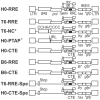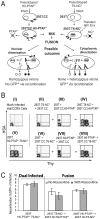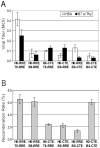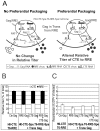Probing the HIV-1 genomic RNA trafficking pathway and dimerization by genetic recombination and single virion analyses
- PMID: 19834549
- PMCID: PMC2757677
- DOI: 10.1371/journal.ppat.1000627
Probing the HIV-1 genomic RNA trafficking pathway and dimerization by genetic recombination and single virion analyses
Abstract
Once transcribed, the nascent full-length RNA of HIV-1 must travel to the appropriate host cell sites to be translated or to find a partner RNA for copackaging to form newly generated viruses. In this report, we sought to delineate the location where HIV-1 RNA initiates dimerization and the influence of the RNA transport pathway used by the virus on downstream events essential to viral replication. Using a cell-fusion-dependent recombination assay, we demonstrate that the two RNAs destined for copackaging into the same virion select each other mostly within the cytoplasm. Moreover, by manipulating the RNA export element in the viral genome, we show that the export pathway taken is important for the ability of RNA molecules derived from two viruses to interact and be copackaged. These results further illustrate that at the point of dimerization the two main cellular export pathways are partially distinct. Lastly, by providing Gag in trans, we have demonstrated that Gag is able to package RNA from either export pathway, irrespective of the transport pathway used by the gag mRNA. These findings provide unique insights into the process of RNA export in general, and more specifically, of HIV-1 genomic RNA trafficking.
Conflict of interest statement
The authors have declared that no competing interests exist.
Figures





Similar articles
-
Subcellular Localization of HIV-1 gag-pol mRNAs Regulates Sites of Virion Assembly.J Virol. 2017 Feb 28;91(6):e02315-16. doi: 10.1128/JVI.02315-16. Print 2017 Mar 15. J Virol. 2017. PMID: 28053097 Free PMC article.
-
Determining the frequency and mechanisms of HIV-1 and HIV-2 RNA copackaging by single-virion analysis.J Virol. 2011 Oct;85(20):10499-508. doi: 10.1128/JVI.05147-11. Epub 2011 Aug 17. J Virol. 2011. PMID: 21849448 Free PMC article.
-
HIV-1 RNA genome dimerizes on the plasma membrane in the presence of Gag protein.Proc Natl Acad Sci U S A. 2016 Jan 12;113(2):E201-8. doi: 10.1073/pnas.1518572113. Epub 2015 Dec 28. Proc Natl Acad Sci U S A. 2016. PMID: 26712001 Free PMC article.
-
[Analysis on primate lentivirus genome dimerization in virion].Uirusu. 2005 Jun;55(1):153-60. doi: 10.2222/jsv.55.153. Uirusu. 2005. PMID: 16308542 Review. Japanese.
-
Life of psi: how full-length HIV-1 RNAs become packaged genomes in the viral particles.Virology. 2014 Apr;454-455:362-70. doi: 10.1016/j.virol.2014.01.019. Epub 2014 Feb 14. Virology. 2014. PMID: 24530126 Free PMC article. Review.
Cited by
-
Application of live-cell RNA imaging techniques to the study of retroviral RNA trafficking.Viruses. 2012 Jun;4(6):963-79. doi: 10.3390/v4060963. Epub 2012 Jun 8. Viruses. 2012. PMID: 22816035 Free PMC article. Review.
-
Opening of the TAR hairpin in the HIV-1 genome causes aberrant RNA dimerization and packaging.Retrovirology. 2012 Jul 24;9:59. doi: 10.1186/1742-4690-9-59. Retrovirology. 2012. PMID: 22828074 Free PMC article.
-
Expression, purification, and functional characterization of soluble recombinant full-length simian immunodeficiency virus (SIV) Pr55Gag.Heliyon. 2023 Jan 10;9(1):e12892. doi: 10.1016/j.heliyon.2023.e12892. eCollection 2023 Jan. Heliyon. 2023. PMID: 36685375 Free PMC article.
-
Purification and Functional Characterization of a Biologically Active Full-Length Feline Immunodeficiency Virus (FIV) Pr50Gag.Viruses. 2019 Jul 27;11(8):689. doi: 10.3390/v11080689. Viruses. 2019. PMID: 31357656 Free PMC article.
-
A short sequence motif in the 5' leader of the HIV-1 genome modulates extended RNA dimer formation and virus replication.J Biol Chem. 2014 Dec 19;289(51):35061-74. doi: 10.1074/jbc.M114.621425. Epub 2014 Nov 3. J Biol Chem. 2014. PMID: 25368321 Free PMC article.
References
-
- Hammarskjold ML. Regulation of retroviral RNA export. Semin Cell Dev Biol. 1997;8:83–90. - PubMed
-
- Swanson CM, Malim MH. Retrovirus RNA trafficking: from chromatin to invasive genomes. Traffic. 2006;7:1440–1450. - PubMed
-
- Rodriguez MS, Dargemont C, Stutz F. Nuclear export of RNA. Biol Cell. 2004;96:639–655. - PubMed
-
- Fornerod M, Ohno M, Yoshida M, Mattaj IW. CRM1 is an export receptor for leucine-rich nuclear export signals. Cell. 1997;90:1051–1060. - PubMed
Publication types
MeSH terms
Substances
Grants and funding
LinkOut - more resources
Full Text Sources

